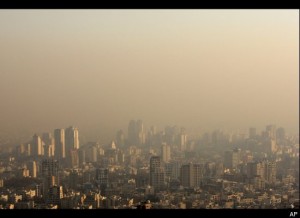 A thick brown haze which has covered nine big cities - including the capital, Tehran - in Iran for the past 10 days is being blamed for thousands of deaths.
A thick brown haze which has covered nine big cities - including the capital, Tehran - in Iran for the past 10 days is being blamed for thousands of deaths.Iran's deputy health minister said some 4,460 people died from air pollution in Tehran in the first nine months of last year.
At the peak of the crisis, hospital admissions were said to have risen by at least a third and the corridors of local clinics were full of wheezing people, children and pregnant women waiting for oxygen and treatment.
The BBC's office in Tehran, located in the highlands in the northern part of the city, often offers a clear view of the sprawling city of Tehran. But these days, I see only the blurred outlines of high-rise buildings and the murky Milad communications tower in the distance.
Walking in the streets of Tehran is impossible without wearing a surgical mask over one's mouth and nose, but people's eyes still tear up and their throats sting from the mist of pollutants, which, according to reports, are made up of particles containing lead, sulphur dioxins and benzene.
Shielded from cleansing winds by the Alborz mountain range that embraces the capital like a crescent moon, flooded with cars and surrounded by cement factories and power stations, Tehran has long been notorious for pollution - particularly during dry winters of still air, such as this one.
But air quality has recently been worse, for longer, than ever before.
Shutdown
According to reports, Tehran enjoys less than 100 healthy days a year. Iran's health ministry has reported a rise in respiratory and heart diseases, as well as an increase in a variety of cancers that it says are related to pollution.
Each year, the 5.5 million vehicles in the city pump an estimated�five million tonnes of CO2 and other poisonous gases into the air.
Some experts believe that domestically-produced petrol suffers from low quality and it has fanned the flames of air pollution.
Donya-e-Eqtesad newspaper, which is critical of the government, asked for an improvement in petrol standards in its editorial on Sunday. However, on state television, several officials denied that the yellow haze had anything to do with the locally-produced fuel.
State organisations, schools, universities and banks reopened on Sunday after the government had ordered them to shut down for five days to help ease the chronic pollution.
Meanwhile, the government has imposed strict traffic regulations in Tehran. An odd-even traffic-control plan based on the last digit of vehicle licence plates takes nearly half the cars off Tehran's streets on a daily basis. But these are short-term tactics, and do not have much of an impact on changing things long-term.
'Quickly forgotten'
Without an effective government plan to curb the pollution, people and officials must wait for the rain and wind to come to wash away the smog.
In the new Farmaniyeh hospital in northern Tehran, children cough as they wait with their mothers for treatment.
Most of them are receiving Diphenhydramine or Prospan syrup.
"Do not rely on this prescription. Listen to your mother and try not to go out at all and drink milk and water as much as you can," Dr Bahrami tells a 10-year-old boy who is coughing after every breath.
"You can mix hot water and honey and make him drink to stop his coughing," Dr Bahrami tells the boy's mother.
Tehran, home to nearly 14 million people, needs a strategic plan to get rid of the deadly pollution.
But when the winds pick up and the smog is dispersed, in the short-term the problem is quickly forgotten, until the next time the brown haze descends.
By BBC
The Iran�Project is not responsible for the content of quoted articles.










